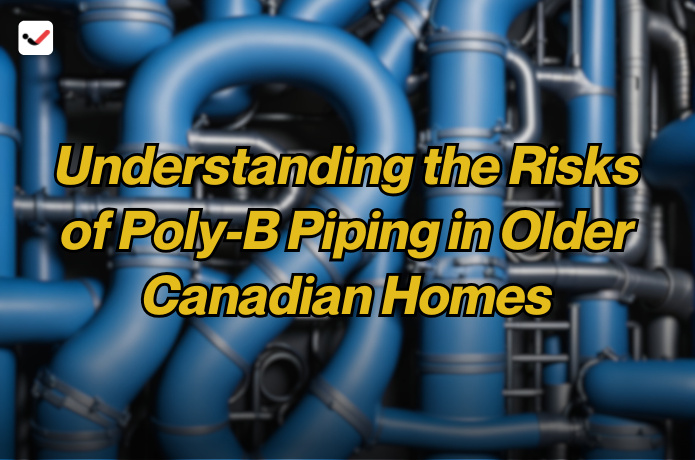Understanding the Risks of Poly-B Piping in Older Canadian Homes
Understanding the Risks of Poly-B Piping in Older Canadian Homes

Poly-B piping, commonly used in homes built in Canada during the 1970s and 1980s, has become a topic of concern for homeowners. While this plumbing material was once considered a cost-effective alternative to copper piping, it has since gained a reputation for being prone to failure. As more Canadian homes age, many property owners are discovering the risks associated with Poly-B piping, particularly the potential for leaks and water damage. This article explores the risks of Poly-B piping in older Canadian homes, what homeowners should be aware of, and the steps they can take to protect their property.
Poly-B piping, also known as cross-linked polyethylene or PEX, was widely used in Canadian homes due to its affordability, flexibility, and ease of installation. However, over time, the material has been found to degrade, leading to leaks, bursts, and even complete pipe failure. The primary issue with Poly-B piping is its sensitivity to pressure changes and temperature fluctuations, which can cause the pipes to weaken or crack. These issues are especially common in homes with older plumbing systems, where Poly-B pipes have been subjected to decades of wear and tear. Understanding the risks of Poly-B piping and taking proactive steps to address potential problems is essential for protecting the integrity of your home and preventing costly damage.
Common Issues with Poly-B Piping
One of the most significant concerns with Poly-B piping is its susceptibility to failure due to chemical reactions. The material’s connectors, which were initially designed to fit tightly together, often weaken over time, making the pipes more prone to leaks. Poly-B pipes are also known to be sensitive to chlorinated water, which is a common issue in many Canadian municipalities. The chlorine in the water can cause the pipes to become brittle, leading to cracks and leaks that may not be immediately visible but can cause extensive water damage if left unchecked.
Another risk associated with Poly-B piping is the potential for water pressure issues. Over the years, Poly-B pipes can lose their structural integrity, resulting in reduced water pressure throughout the home. In some cases, the pipes may collapse or break entirely, causing sudden flooding or significant water loss. While this may not happen overnight, gradual wear and tear can lead to serious plumbing problems that require costly repairs or replacements. Homeowners who live in older homes with Poly-B piping should be aware of these potential issues and take steps to monitor the condition of their plumbing system.
Signs of Poly-B Pipe Failure
Homeowners may notice several warning signs that indicate Poly-B piping is beginning to fail. One of the most common signs is visible leaks or damp spots in walls, ceilings, or floors. Since Poly-B pipes are often hidden behind drywall or beneath floors, it may be difficult to spot leaks right away. However, if you notice an increase in water stains, a musty odor, or wet spots in unexpected areas, these could be signs of a failing pipe.
Another indication of Poly-B pipe failure is inconsistent water pressure. If you experience sudden drops in water pressure, or if water flow is intermittent in certain areas of the home, it may be due to a damaged or corroded Poly-B pipe. You may also notice a change in the color or taste of your water, which can occur if the pipes are deteriorating and releasing particles into the water supply. Any of these signs should prompt a homeowner to have their plumbing system inspected by a professional plumber who can identify and address any Poly-B piping issues before they lead to further damage.
The Cost of Replacing Poly-B Piping
Replacing Poly-B piping in older homes can be an expensive and time-consuming process. The cost of replacing these pipes depends on several factors, including the size of the home, the complexity of the plumbing system, and the extent of the damage. On average, homeowners can expect to pay anywhere from $3,000 to $8,000 for a complete Poly-B pipe replacement. This price includes the cost of labor, materials, and any necessary permits or inspections. Although this may seem like a significant investment, replacing aging Poly-B pipes can prevent the need for more costly repairs down the line, such as water damage restoration or foundation repairs caused by leaks.
Many homeowners find that replacing Poly-B piping not only improves the safety and reliability of their plumbing system but also increases the value of their property. Potential buyers may be hesitant to purchase a home with outdated or unreliable plumbing, especially if they are aware of the risks associated with Poly-B piping. By replacing the pipes with more durable materials, such as copper or PEX, homeowners can ensure their property is more attractive to buyers and may even increase its market value.
How to Prevent Problems with Poly-B Piping
While replacing Poly-B piping is often the best solution for addressing potential issues, there are a few steps homeowners can take to reduce the risk of failure and extend the life of their existing pipes. Regular inspections by a licensed plumber can help identify any early signs of wear or damage, allowing for timely repairs before more extensive issues arise. If you live in an area with high levels of chlorine in the water, consider installing a water filtration system to reduce the strain on your plumbing system and prevent the pipes from becoming brittle.
In addition, it is essential to monitor your home’s water pressure regularly. If you notice a sudden decrease in water pressure or find that the water flow is inconsistent, it may be a sign that your Poly-B pipes are starting to fail. A professional plumber can perform a thorough inspection and recommend the necessary repairs or replacements. By staying vigilant and addressing problems early, homeowners can avoid the major risks associated with Poly-B piping in older Canadian homes.
Poly-B piping was once considered a reliable and affordable plumbing material for Canadian homes. However, over time, the material has shown to be prone to failure, leading to leaks, reduced water pressure, and potential water damage. Homeowners with older homes that contain Poly-B pipes should be aware of the risks and take steps to monitor the condition of their plumbing system. Regular inspections and early detection of issues can help prevent costly damage and ensure that your plumbing system remains safe and reliable for years to come. While replacing Poly-B piping may require a significant investment, the peace of mind and long-term savings it offers are well worth the cost.

